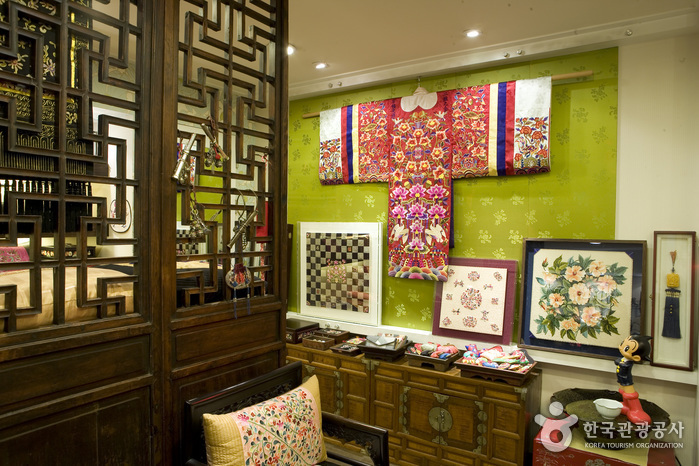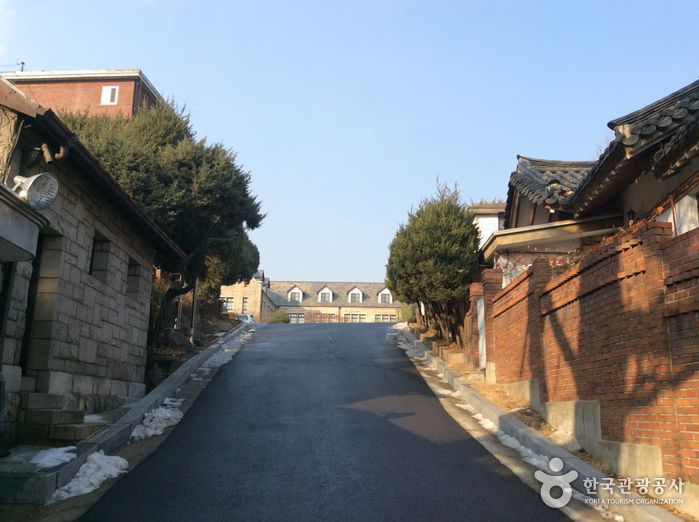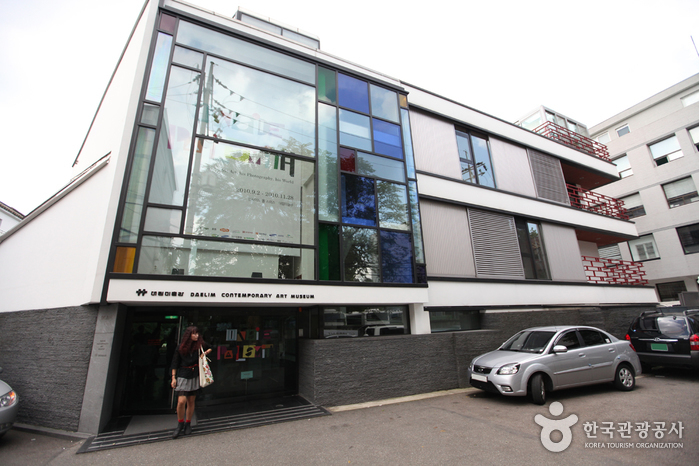Lee Seo-yun Hanbok (이서윤한복)
730.3453975408047m 15915 2020-04-11
7, Hyoja-ro, Jongno-gu, Seoul
+82-2-735-4250
Lee Seo-yun Hanbok seeks hanbok that blends both traditional Korean and western designs. It not only weaves fabrics for its own hanbok, but dyes them as well. The main items cover party dresses, wedding dresses, ornaments, cushions, and sitting cushions. Lee Seo-yun, the owner of the store, was responsible for clothing and ornaments shown in the Korean soap opera, Iljimae and his works have appeared in many soap operas, traditional Korean dance performances and fashion shows as well.
CheongKwanJang - Jonggak Station Branch [Tax Refund Shop] (정관장 종각역)
730.8879598402367m 0 2024-04-22
#102, 95, Sambong-ro, Jongno-gu, Seoul
-
Ipamnamu - Insa Branch [Tax Refund Shop] (이팝나무 인사)
736.9648393619775m 0 2024-04-18
4, Insadong 5-gil, Jongno-gu, Seoul
-
National Souvenirs Center [Tax Refund Shop] (한국관광명품점)
738.1574441977981m 0 2024-04-23
14, Insadong 5-gil, Jongno-gu, Seoul
-
Insa-Dong National Souvenir Center (한국관광명품점(인사동))
742.7159637287136m 32092 2020-11-07
14, Insadong 5-gil, Jongno-gu, Seoul
+82-2-735-6529
Operated by the Ministry of Culture, Sports, and Tourism and Korea Tourism Association, the National Souvenir Center has strict standards for the brands sold, only allowing those which have won various prizes and passed thorough screening. Shoppers can be assured of high quality and high class products.
Olens - Gwanghwamun Branch [Tax Refund Shop] (오렌즈 광화문)
742.381821389105m 0 2024-04-18
1F, 82, Sambong-ro, Jongno-gu, Seoul
-
Doore (두레)
743.5584345854156m 21296 2024-03-18
30 Samcheong-ro, Jongno-gu, Seoul
+82-2-732-2919
Doore is a traditional Korean restaurant known for using seasonal ingredients and house-fermented soybean paste. They offer set menus such as maehwa course (pork bulgogi), gukhwa course (beef bulgogi), and moran course (braised galbi and grilled fish). Meals are enjoyed in the following sequence: porridge, salad, pan-fried battered zucchini, hansang (rice, soup, seasonal salad, side dishes), main course, and tea. They also serve à la carte dishes like yukhoe bibimbap (beef tartare bibimbap), Eonyangsik bulgogi (Eonyang bulgogi), and galbitang (galbi soup).
Choong Ang High School (중앙고등학교)
748.6567121079053m 15191 2019-11-26
164, Changdeokgung-gil, Jongno-gu, Seoul
+82-2-742-1321
Choong Ang High School is located in Jong-ro near Samcheongdong-gil. It was built to educate the public at the beginning of the 20th century. The school’s main building was reconstructed in 1937 after the original two-story brick house was destroyed in 1934. The main building situated in front of the main gate is a two-story H-shaped granite stone building in Gothic style, with a four-story tower in the middle.
The school holds historical significance because it was designed by Park Dong Jin, one of Korea's first modern architects and the designer of Korea University’s main building, library, and the Chosun Ilbo Newspaper Company building. The main building of Choong Ang High School is designated as Historic Site No. 281. Many national leaders were educated at the gothic building during the grim period when Korea was trying to escape Japanese colonial rule.
Sieunjae [Korea Quality] / 시은재 [한국관광 품질인증]
748.3075954221039m 4798 2020-12-10
439, Samil-daero, Jongno-gu, Seoul
+82-10-5355-3029
Located in Gyeongun-dong, Jongno-gu at the very heart of Seoul, Sieunjae is a hanok with a longstanding tradition. It has three guestrooms including the anbang (main room), byeolchae (detached building), and jakeunbang (small room). The anbang is the only room with a living room, where various items of old furniture, including a comfortable sofa, create an antique atmosphere. The communal bathroom and toilets are supplied with toiletries, while the communal kitchen is equipped with cooking equipment and a washing machine.
The house can be rented either as individual accommodations or in its entirety. As it is situated in Jongno-gu, at the very heart of Seoul, guests can easily reach many nearby major tourist attractions. Car users are advised to use the public parking lot as the house has no parking spaces. Entering by a small gate, the little flowerbed comes into sight. This old hanok shows traces of repair works on the tiled roof.
Daelim Museum (대림미술관)
759.3010623886954m 33535 2022-07-29
21, Jahamun-ro 4-gil, Jongno-gu, Seoul
+82-2-720-0667
The Daelim Museum, built by the Daelim Group, was first established in Daejeon in 1996 and later moved to Jongno, Seoul in 2002. The art gallery studies, analyzes, and presents modern art through the lens of photography and holds exhibitions centered around photo media.
The museum is located in the residential area of Tongui-dong, near the time-honored Gyeongbokgung Palace. The museum, which was designed by French architect, Vincent Cornu, and built by the Daelim Corporation, opened its door to the public in late May 2002.
On the first floor, there is a garden, parking lot, reception desk, storage area, and conference room. On the second and third floor are offices and exhibition hall approximately 595 m² in size, consisting of small and large rooms, a long gallery, and a special high-ceilinged exhibition space. On the fourth floor, there is a seminar room that can seat up to 120 guests and a balcony with a beautiful view. From the balcony of the seminar room, Visitors can also enjoy a wide open view of Inwangsan Mountain and Bukhansan Mountain. The stained glass panels (designed to reflect the beauty of traditional Korean wrapping cloth) and the scenic lounges on the 2nd and 3rd floors of the building add to the overall charm.
Above all else, the museum was designed with consideration of the photos, which are very sensitive to humidity, light, and temperature.

![CheongKwanJang - Jonggak Station Branch [Tax Refund Shop] (정관장 종각역)](http://tong.visitkorea.or.kr/cms/resource/13/2878213_image2_1.jpg)
![Ipamnamu - Insa Branch [Tax Refund Shop] (이팝나무 인사)](http://tong.visitkorea.or.kr/cms/resource/08/2878208_image2_1.jpg)

![Olens - Gwanghwamun Branch [Tax Refund Shop] (오렌즈 광화문)](http://tong.visitkorea.or.kr/cms/resource/17/2878217_image2_1.jpg)

![Sieunjae [Korea Quality] / 시은재 [한국관광 품질인증]](http://tong.visitkorea.or.kr/cms/resource/51/2447351_image2_1.jpg)

 English
English
 한국어
한국어 日本語
日本語 中文(简体)
中文(简体) Deutsch
Deutsch Français
Français Español
Español Русский
Русский